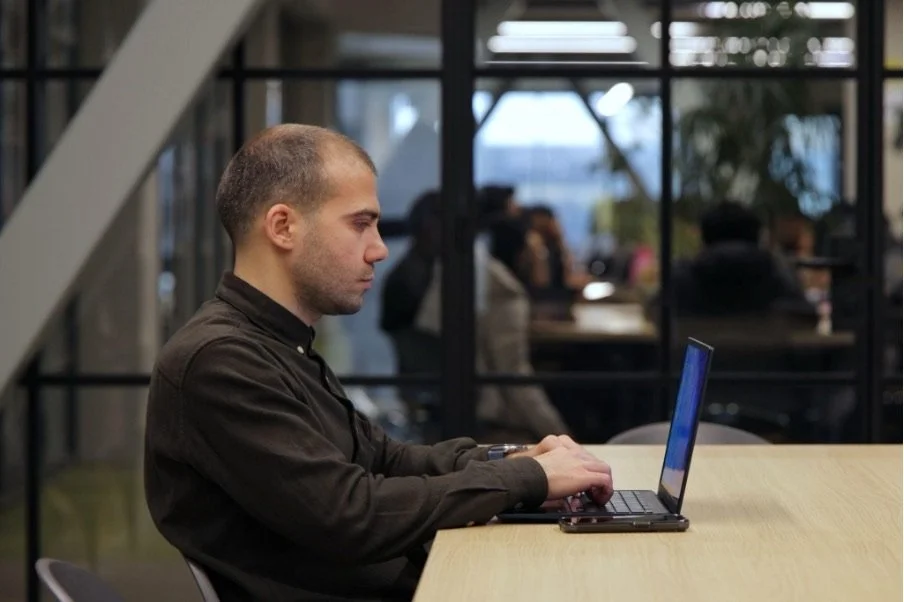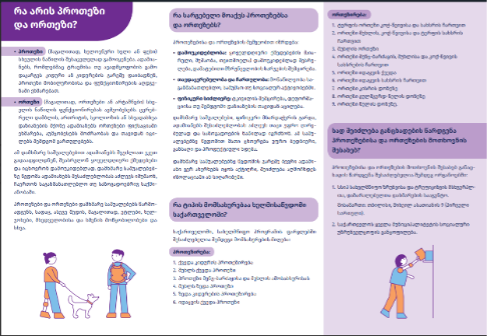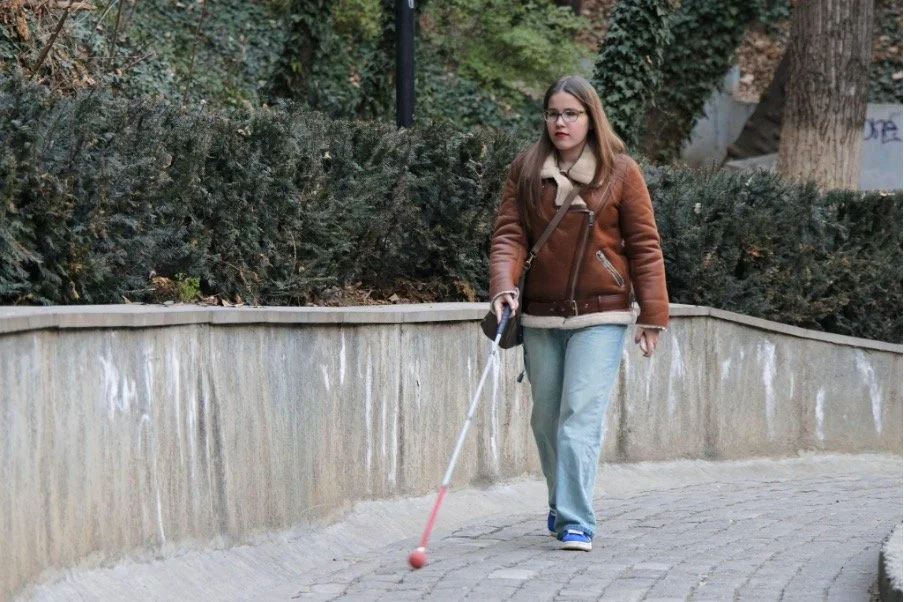Davit Bibileishvili, a lecturer and a disability rights activist in Georgia, working on his accessible computer. Photo: WHO Georgia
When Davit Bibileishvili opens his laptop, the voice of a screen reader flows effortlessly through his headphones, turning what others see into what he can hear. For this disability rights advocate and lecturer in Georgia, assistive technology (AT) isn’t simply a tool; it’s a means to independence.
“For blind and visually impaired individuals, having access to a variety of assistive products is crucial,” Davit says. “They allow us to integrate into society: into education, employment, mobility, and so many other parts of life. These tools helped me pursue higher education independently. Thanks to my digital devices, I even created an original university-level course- for Bachelor of Arts students- focused on the rights of persons with disabilities.”
As a key step toward improving access, quality, and standardization of assistive products, WHO Georgia convened a multi-stakeholder workshop with policymakers, technical experts, service providers, and user representatives. Photo: WHO Georgia
Davit’s experience reflects a broader shift in Georgia’s approach to inclusion. According to the WHO’s 2021 estimates, there were 33,300 wheelchairs, 62,900 hearing aids, and 25,900 mobility products currently needed in Georgia. The needs are vast; only a fraction of them are being met. However, there is a growing intention and action to effect change.
Change begins with policy
In 2021, the country formally adopted its National List of Priority Assistive Products, aligning with the WHO Priority Assistive Products List—an initiative supported by WHO and ATscale. Since then, Georgia has expanded state-funded AT from 13 products in 2022 to 20 in 2024, covering mobility aids, orthotic and prosthetic devices, hearing and communication aids, vision aids, self-care products, and cognitive aids. In the upcoming year, the Ministry of Health is considering expanding the state-covered products to include talking watches and daisy readers. There is ongoing work to strengthen the government’s procurement capacities, including training on product quality and specifications, as well as the development of national standards.
Integrating AT provision into national health systems
With ATscale’s support, WHO is playing a crucial role in integrating AT into Georgia’s national health system. The efforts are focused on creating an enabling ecosystem that includes product availability, a trained workforce, strong service delivery mechanisms, and supportive policy frameworks. Currently, the focus is on improving access to mobility aids at primary healthcare centres (PHCs) in Samegrelo and Adjara regions.
WHO is supporting the procurement and provision of mobility, toilet, and self-care products through PHCs, as well as strengthening national provision through public-private partnerships. The Ministry of Health identified low uptake of simple walking aids—such as walkers, canes, and crutches—through its voucher system, as many users opted to purchase them directly from their nearest pharmacy. To address this, Aversi, one of Georgia’s largest distributors of pharma and non-pharma products, was registered as a state supplier, leveraging its nationwide network to bring products closer to rural communities.
Moreover, Georgia is strengthening its AT workforce through national workshops, inter-country learning exchanges, and by rolling out WHO’s Training in Assistive Products (TAP) for the health workforce at these PHCs for AT-strengthened service delivery. Therefore, multiple pillars of product delivery and systems strengthening are converging at PHCs to integrate AT provision into national health systems.
Investment in access
Globally, the WHO estimates 2.5 billion people need one or more assistive products today, a figure projected to reach 3.5 billion by 2050 as populations age and non-communicable diseases rise. Georgia is making deliberate investments to address their domestic needs.
Georgia’s commitment to inclusive health access is evident in its significant budget increase for assistive technology (AT). The budget has risen from 6.5 million GEL (USD 2.4 million) in 2023 to a projected 8.5 million GEL (USD 3 million) in 2025, marking a nearly 31 %increase over two years. This increase in funding has allowed the government to fully cover the cost of paediatric wheelchairs, electric wheelchairs, and hearing aids, with only a small co-payment applying to select adult groups for manual wheelchairs. While eyeglasses remain outside the current funding scheme, findings from a recent eye care situation analysis strongly recommend their inclusion.
However, access to products alone was not enough; users lacked the appropriate services to guide their selection and use. To incentivize uptake and ensure quality service delivery, primary healthcare (PHC) providers now receive a 20 GEL consultation fee for each assistive technology (AT) user served – a first for the country. With the support of WHO and ATscale, selected PHCs were strengthened to provide assessment-based services, ensuring that users receive the appropriate products.
Strengthening service delivery
The ongoing work also helped identify gaps in the service delivery of AT. For example, to address the gap in referral guidance for patients undergoing amputation, a structured prosthetics and orthotics (P&O) referral pathway was developed in direct response to requests from medical professionals. Recognizing the need for clear, accessible information, a dedicated leaflet was created to support clinicians in directing patients to appropriate service providers.
This leaflet serves as a practical tool, detailing:
● The types of prosthetic and orthotic devices available under Georgia’s state-funded programme;
● The required documentation and step-by-step procedures for applying;
● Submission points for applications and contact information for further assistance.
By standardizing referral information and streamlining access, the leaflet strengthens coordination between hospitals, rehabilitation teams, and P&O providers—ensuring timely and equitable access to assistive devices for individuals with limb loss.
“The policy changes, growing budgets, workforce development, and user-centred design are all converging in Georgia's assistive technology initiatives. This approach ensures that every Georgian's unique needs will be considered in the future, and no one will be held back by the absence of the tools they need to live independently”. Said Dr. Silviu Domente, WHO Representative and Head of the Country Office in Georgia.
Ana Sikhashvili, a disability rights activist and university student in Georgia, on the way to her classroom. Photo: WHO Georgia
For Ana Sikhashvili, a disability rights activist, true accessibility means having multiple options to match individual needs:
“When I go to university, I shouldn’t have to rely only on my laptop. I should have multiple options, such as reading materials in Braille, using a note-taker, or listening to audiobooks. Without these voice programmes and a computer, I wouldn’t be able to function.”



